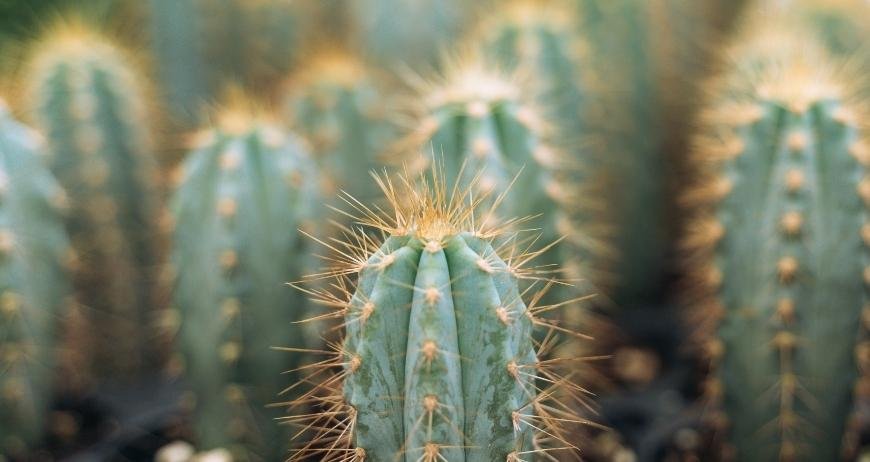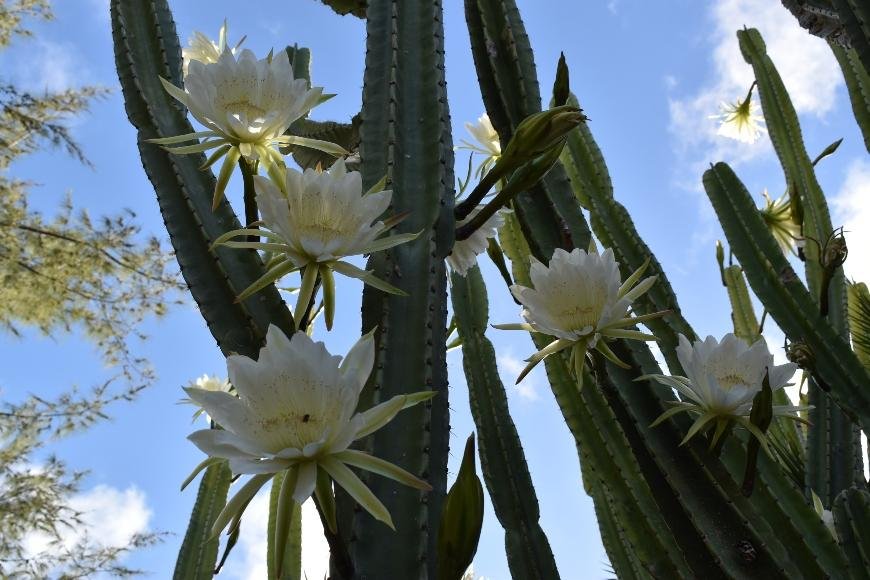What is Mescaline Cacti?
Explore "What is Mescaline Cacti" with our guide on history, effects, and legality of Peyote and San Pedro for psychedelic experiences.

What is Mescaline Cacti? As a natural psychedelic compound found in certain species of cacti, mescaline has been used for centuries by indigenous cultures for its mind-altering effects. In this post, we'll explore the history and effects of mescaline cacti as well as their potential risks, from its traditional uses to its modern-day recreational popularity.
We'll discuss the origins of mescaline use in traditional rituals and ceremonies before examining how it gained popularity as a recreational substance. Furthermore, you'll learn about the various types of cacti that hold this powerful compound such as peyote (Lophophora williamsii) and San Pedro (Echinopsis pachanoi).
As we uncover the unique properties of these plants and compare them to other psychedelics like magic mushrooms, our goal is to provide an insightful understanding into what makes mescaline cacti so intriguing. So, come with us as we explore the amazing world of this potent psychedelic from nature.
Table of Contents:
- What is Mescaline Cacti?
- History of Mescaline Cacti Use
- Effects of Mescaline Cacti Use
- Side Effects of Mescaline Cacti Use
- Is Mescaline Cacti Safe?
- Legality & Availability
- FAQs in Relation to What is Mescaline Cacti
- Conclusion
What is Mescaline Cacti?
Mescaline cacti are a type of cactus that contain the psychoactive compound mescaline. This compound has been used for centuries by indigenous cultures in North and South America for spiritual and medicinal purposes. These unique plants have gained popularity among young adults who grow and take drugs recreationally, such as magic mushrooms.
The primary species of mescaline-containing cacti include:
- Peyote (Lophophora williamsii): This small, spineless cactus is native to Mexico and southwestern Texas.
- San Pedro (Echinopsis pachanoi): A tall, columnar cactus found throughout the Andes region in South America.
- Peruvian Torch (Echinopsis peruviana): Similar to San Pedro but with slightly different morphology; it's also native to the Andes region.
In addition to their natural form, synthetic mescaline can be produced in laboratories. However, many users prefer consuming these psychoactive substances through traditional methods like ingesting parts of the actual mescaline-producing plants or brewing them into teas or concoctions called "huachuma."
While some people may experiment with these powerful psychedelics out of curiosity or recreational interest, others use them for personal growth experiences or therapeutic purposes under controlled settings guided by experienced practitioners.
For those wishing to find out more about mescaline cacti - such as their history, impacts on users' brains and bodies, possible adverse effects, safety factors and legal status - this article provides the necessary information.
Mescaline cacti, a powerful psychedelic with an extended history of use by indigenous cultures, have captivated the modern world. With its fascinating history, it is no wonder why mescaline cacti have become so popular in modern times; let's take a closer look at their past use.
History of Mescaline Cacti Use
The use of mescaline cacti dates back thousands of years, with indigenous cultures in North and South America utilizing these psychoactive plants for spiritual and medicinal purposes. The two most commonly used species are the peyote cactus (Lophophora williamsii) and the San Pedro cactus (Echinopsis pachanoi). These unique plants have played a significant role in various traditional practices, providing insight into their historical importance.
Peyote Cactus: Ancient Rituals & Ceremonies
For centuries, Native American tribes such as the Huichol people of Mexico and the Navajo tribe in the United States have been using peyote cactus for religious ceremonies. It is often consumed during religious ceremonies to induce visions, connect with ancestors or deities, and promote healing. Archaeological evidence suggests that peyote was utilized by ancient cultures as far back as 5,700 years ago.
San Pedro Cactus: A Sacred Plant Among Andean Cultures

In contrast to its North American counterpart, San Pedro cactus is native to South America's Andean region where it has been revered by local communities like Chavin culture from Peru since at least 1300 BCE. This sacred plant is traditionally ingested during shamanic rituals aimed at diagnosing illnesses or seeking guidance from other realms.
Magic Mushrooms & Other Psychedelics in Historical Context
- Magic mushrooms: Similar to mescaline cacti, magic mushrooms have been used by indigenous cultures for millennia. These fungi contain the psychoactive compound psilocybin and are often consumed during spiritual ceremonies or rituals.
- Ayahuasca: Another powerful psychedelic plant native to South America is ayahuasca, a brew made from the Banisteriopsis caapi vine and other plants containing DMT. This concoction has been utilized by Amazonian tribes for centuries as part of their religious practices.
In recent times, these old substances have seen a resurgence of interest due to their possible curative benefits and capacity to help people reach remarkable personal development. But, it is imperative to bear in mind that any type of psychedelic ingestion should be treated with care and consideration for its traditional roots.
Stretching far back in antiquity, the Aztecs utilized mescaline cacti for their spiritual ceremonies. Moving forward in time, we can now explore the effects that consuming these plants has on its users.
3. Effects of Mescaline Cacti Use
The effects of mescaline cacti use can vary depending on factors such as the dose taken, individual sensitivity, and the specific type of cactus consumed (such as peyote or San Pedro). However, there are some common experiences reported by users that help paint a picture of what one might expect when consuming these psychoactive plants.
Altered Perception & Visual Hallucinations
Mescaline is known for its ability to induce vivid visual hallucinations and alter one's perception of reality. Users often report seeing geometric patterns, colorful shapes, and intricate designs while under the influence. These visuals can be both open-eye and closed-eye in nature.
Euphoria & Emotional Insight
A sense of euphoria is commonly experienced during a mescaline trip. This feeling may be accompanied by increased self-awareness and introspection, leading to personal insights or revelations about oneself or their surroundings.
Increase in Heart Rate & Physical Sensations
Much like other psychedelics such as magic mushrooms, mescaline can cause an increase in heart rate along with heightened physical sensations. Some users describe feeling more connected to their body or experiencing synesthesia - where senses become intertwined (e.g., hearing colors).
Nausea & Vomiting:
- It is not uncommon for users to experience nausea and vomiting during the onset of a mescaline trip. The bitter taste and alkaloids of the cactus can lead to nausea and vomiting during a mescaline trip, though individual reactions may differ depending on one's environment.
While these effects are generally considered part of the overall mescaline experience, it's important to remember that individual reactions may vary. Set and setting also play a crucial role in shaping one's journey with these powerful plants.
Indigenous cultures have long employed mescaline cacti for spiritual and therapeutic purposes, yet it is essential to be cognizant of the potential impacts prior to engaging in its utilization. When utilizing mescaline cacti, it is essential to be aware of the potential consequences that could come with such an experience.
4. Side Effects of Mescaline Cacti Use
It is vital to be mindful that individual reactions and doses taken may vary when using mescaline cacti, so one should exercise caution and respect. It is important to remember that everyone's experience with psychedelics like mescaline cacti will differ, so it is crucial to approach these substances with caution and respect.
Potential Short-Term Side Effects:
- Anxiety: Some users may experience feelings of anxiety or panic during their trip, which could lead to a negative experience.
- Paranoia: Mescaline can sometimes cause paranoia or irrational fears in users, especially if they have pre-existing mental health issues.
- Nausea & Vomiting: As with many psychedelics such as magic mushrooms (Psilocybe cubensis) and LSD, mescaline cacti can cause nausea and vomiting in some individuals.
- Dizziness & Headaches: Users might feel dizzy or lightheaded while under the influence of mescaline cactus; headaches are also a possibility after ingestion.
- Increase Heart Rate: Much like other stimulants such as caffeine or amphetamines, using mescaline from peyote or San Pedro (Echinopsis pachanoi) can result in an increased heart rate for some people. This effect should be monitored closely by those who have pre-existing heart conditions.
Potential Long-Term Side Effects:
While mescaline cacti are not considered to be physically addictive, there is still the potential for psychological dependence or abuse. Some long-term side effects that may arise from frequent use include:
- Hallucinogen Persisting Perception Disorder (HPPD): This rare condition involves experiencing flashbacks of hallucinations or visual disturbances even after ceasing use of the substance.
- Mental Health Issues: Frequent use of psychedelics like mescaline can exacerbate pre-existing mental health conditions such as anxiety, depression, and psychosis.
- Tolerance & Cross-Tolerance: Regular users might develop a tolerance to mescaline's effects over time, requiring higher doses to achieve the same results. Additionally, cross-tolerance with other psychedelics like LSD and magic mushrooms could occur.
In order to minimize these risks and ensure a safe experience with mescaline cacti, it is essential for users to educate themselves on proper dosage guidelines and adhere to harm reduction practices such as having a sober trip sitter present during their journey. For more information on responsible psychedelic use and safety precautions, check out resources.
5. Is Mescaline Cacti Safe?
When taken in moderation and under the supervision of an experienced practitioner or guide, mescaline cacti can be considered safe to use. Despite its safety when used in moderation and under proper supervision, mescaline cacti may still present risks due to its psychoactive effects and potential for interactions with other substances or medications.
Potential Risks & Precautions
- Mental Health: Individuals with a history of mental health issues such as anxiety, depression, bipolar disorder, or schizophrenia should exercise caution when using mescaline cacti as they may exacerbate these conditions.
- Physical Health: People suffering from heart problems or high blood pressure should avoid using mescaline cacti due to their potential impact on cardiovascular function.
- Pregnancy & Breastfeeding: Pregnant women and breastfeeding mothers are advised against consuming mescaline-containing plants as the effects on unborn children and infants are not well understood.
- Mixing Substances: Combining mescaline cacti with other drugs (including alcohol) can lead to unpredictable effects and increase the risk of negative side effects. It's essential to research possible interactions before combining substances.
Tips for Safe Use

- Educate Yourself: Gather information about different types of mescaline cactus species like peyote (Lophophora williamsii) and San Pedro (Echinopsis pachanoi), their effects, and proper dosages to ensure a safe experience.
- Set & Setting: Create a comfortable environment with trusted friends or an experienced guide to minimize the risk of negative experiences during your mescaline cacti journey.
- Start Low & Go Slow: Begin with a low dose and gradually increase it over time. This approach allows you to gauge your body's reaction to the substance and avoid potential adverse effects.
- Stay Hydrated: Drinking water throughout your experience can help reduce nausea and other physical side effects associated with mescaline cacti use.
Indigenous cultures of North and South America have been utilizing mescaline cacti for spiritual purposes for generations. To ensure a safe experience, it is important to be knowledgeable and mindful of the potential risks associated with mescaline cacti use. Remember always to respect the power of these plants and educate yourself on their proper use before embarking on this unique journey into altered states of consciousness.
Legality & Availability
Mescaline cacti, such as the peyote cactus and San Pedro cactus (Echinopsis pachanoi), are illegal in many countries around the world due to their psychoactive properties. In certain places, it may be obtainable from select vendors where its use is not outlawed.
In the United States, for example, peyote is classified as a Schedule I controlled substance under federal law. However, its use is permitted within specific religious contexts through organizations like the Native American Church. The San Pedro cactus remains legal to grow and possess for ornamental purposes but becomes illegal when prepared for consumption or sold with intent to consume.
- United States: Peyote is a Schedule I controlled substance; San Pedro is legal to grow but illegal when prepared for consumption.
- Canada: Mescaline-containing plants are listed as controlled substances under Canadian law.
- Australia: Both peyote and San Pedro are considered controlled plants in Australia.
- New Zealand: Mescaline-containing plants fall under New Zealand's Psychoactive Substances Act of 2013.
If you're interested in exploring mescaline cacti further, it's essential that you check your local laws before attempting to purchase or consume any form of mescaline cactus product. It's critical to be aware that the manufacture and use of artificial mescaline is prohibited in most nations, presenting possible extra hazards due to its potency and potential for impurities.
For those living in areas where mescaline cacti are legal, they may be purchased from reputable suppliers who specialize in magic mushrooms, ethnobotanicals, or other plant-based psychoactive substances. Always exercise caution when purchasing any substance online, as the quality and legality of products can vary greatly between vendors.
Finding Legal Alternatives
If you're interested in exploring natural psychedelics legally within your country's regulations, there are alternative substances that might provide similar experiences while staying on the right side of the law. For example, magic mushrooms are legal in some countries and can provide a psychedelic experience without the use of mescaline cacti.
Therefore, it is essential to be cognizant of the legal framework concerning mescaline cacti prior to attempting acquisition or consumption. By doing so, you'll ensure that you're staying safe and within the boundaries of legality while exploring these natural psychedelics. While synthetic mescaline is also available, it's important to note that it is illegal in many countries as well. Cacti hold a special place in the world of psychedelics, with the peyote cactus, San Pedro cactus, and Echinopsis pachanoi being some of the most popular varieties.
FAQs in Relation to What is Mescaline Cacti
Which part of the cactus has mescaline?
The mescaline is primarily found in the outer layer of the cactus, known as the skin or cortex. This part contains a higher concentration of alkaloids compared to other parts like the core and roots. For most species, such as Peyote (Lophophora williamsii) and San Pedro (Echinopsis pachanoi), users remove this outer layer for consumption.
Which mescaline cactus grows the fastest?
Echinopsis pachanoi, commonly known as San Pedro, is considered one of the fastest-growing mescaline-containing cacti. It can grow up to 12 inches per year under optimal conditions. Other species like Lophophora williamsii (Peyote) are slower growing, taking several years to reach maturity.
Do all Lophophora contain mescaline?
All Lophophora species contain varying amounts of psychoactive alkaloids including mescaline; however, concentrations may differ significantly between individual plants and even within different parts of a single plant. The most well-known species containing significant levels of mescaline is Lophophora williamsii (Peyote).
Is Mescaline Cacti legal in the US?
Mescaline-containing cacti are generally illegal in the United States due to their psychoactive properties; however, there are some exceptions for religious use by members of certain Native American tribes through the Controlled Substances Act. Growing these plants without consuming them might be allowed depending on state laws, but it's important to check local regulations before cultivating any potentially illegal substances.
Conclusion
Once informed of the characteristics, background, effects and potential harms of mescaline cacti, it is essential to be aware that while they may offer some benefits when used cautiously and sparingly, there are also considerable risks associated. The psychedelic experience can be intense and unpredictable for each individual.
If you are interested in exploring alternative states of consciousness or expanding your mind through natural means like mescaline cacti or magic mushrooms, it's crucial to do thorough research beforehand. It's also recommended to approach these substances with caution and respect for their power.






































































































































